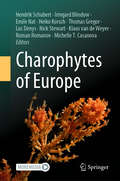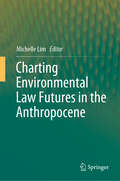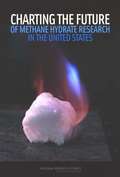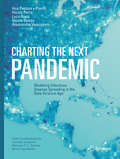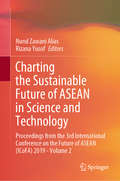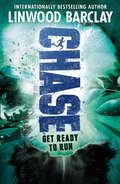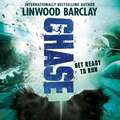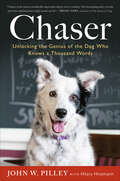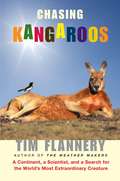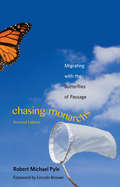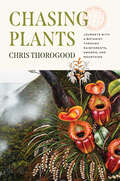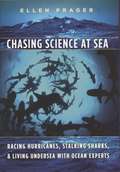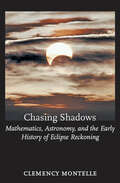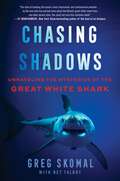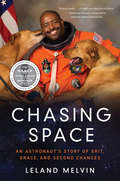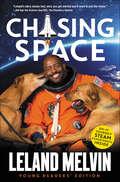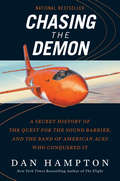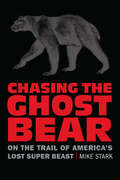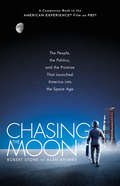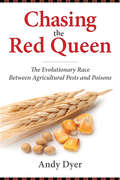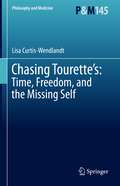- Table View
- List View
Charophytes of Europe
by Hendrik Schubert Irmgard Blindow Emile Nat Heiko Korsch Thomas Gregor Luc Denys Nick Stewart Klaus van de Weyer Roman Romanov Michelle T. CasanovaThis book covers whole Europe within its geographical limits, providing not only an overview about biogeography and recent taxonomic status of Charophyte species but also in-depth information about recent knowledge about ecology, ontogenesis, morphology, palaeontology and systematics of this group of algae. This is the first comprehensive treatment of European Charophytes. In addition, the reader for the first time is provided by definitions of terms applied to Charophytes, sorting out several previous confusions about terminology. Special attention was paid on oospores in order to exploit their potential for supporting species delineation as well as analysis of sediment records. A red list, dealing also with threats and habitat conditions, completes the book.Altogether more than 70 taxon are described in detail, each of the descriptions giving full information about morphology, habitat conditions, distribution as well as variability; important characters for determination are illustrated by photographs and drawings. Hints for correct determination are given in a separate para, allowing correct species delineation even for critical species. This, together with a set of determination keys, will allow beginners and practitioners to get familiar with the determination of Charophytes, being often regarded notoriously difficult in the past.Authored by a large group of 70 specialists from all over Europe and Overseas, a commonly agreed taxonomy is provided, and all debates about taxonomic status and nomenclatural problems have been discussed beforehand extensively. By this, a sound reference for applied aspects is given, allowing for reliable cross-country comparisons especially with respect to bioindication purposes but also serving ground for biogeographical research, biodiversity issues and the emerging field of elucidating the process of territorialisation of land plants. The authors hope that this book will become the reference work for the coming decades it was designed for.
Charting Environmental Law Futures in the Anthropocene
by Michelle LimThis book explores a range of plausible futures for environmental law in the new era of the Earth’s history: the Anthropocene. The book discusses multiple contemporary and future challenges facing the planet and humanity. It examines the relationship between environmental law and the Anthropocene at governance scales from the global to the local. The breadth of issues and jurisdictions covered by the book, its forward-looking nature, and the unique generational perspective of the contributing authors means that this publication appeals to a wide audience from specialist academics and policy-makers to a broader lay readership.
Charting The Future Of Methane Hydrate Research In The United States
by Committee to Review the Activities Authorized Under the Methane Hydrate Research Development Act of 2000Methane hydrate is a natural form of clathrate - a chemical substance in which one molecule forms a lattice around a "guest" molecule with chemical bonding. In this clathrate, the guest molecule is methane and the lattice is formed by water to form an ice-like solid. Methane hydrate has become the focus of international attention because of the vast potential for human use worldwide. If methane can be produced from hydrate, a reasonable assumption given that there are no obvious technical or engineering roadblocks to commercial production, the nation's natural gas energy supply could be extended for many years to come. This report reviews the Department of Energy's (DOE) Methane Hydrate Research and Development Program, the project selection process, and projects funded to date. It makes recommendations on how the DOE program could be improved. Key recommendations include focusing DOE program emphasis and research in 7 priority areas; incorporating greater scientific oversight in the selection, initiation, monitoring, and assessment of major projects funded by the DOE; strengthening DOE's contribution to education and training through funding of fellowships, and providing project applicants with a set of instructions and guidelines outlining requirements for timely and full disclosure of project results and consequences of noncompliance.
Charting the Next Pandemic: Modeling Infectious Disease Spreading in the Data Science Age
by Alessandro Vespignani Luca Rossi Bruno Gonçalves Nicola Perra Ana Pastore y Piontti Nicole Samay Corrado Gioannini Marcelo F. GomesThis book provides an introduction to the computational and complex systems modeling of the global spreading of infectious diseases. The latest developments in the area of contagion processes modeling are discussed, and readers are exposed to real world examples of data-model integration impacting the decision-making process. Recent advances in computational science and the increasing availability of real-world data are making it possible to develop realistic scenarios and real-time forecasts of the global spreading of emerging health threats.The first part of the book guides the reader through sophisticated complex systems modeling techniques with a non-technical and visual approach, explaining and illustrating the construction of the modern framework used to project the spread of pandemics and epidemics. Models can be used to transform data to knowledge that is intuitively communicated by powerful infographics and for this reason, the second part of the book focuses on a set of charts that illustrate possible scenarios of future pandemics. The visual atlas contained allows the reader to identify commonalities and patterns in emerging health threats, as well as explore the wide range of models and data that can be used by policy makers to anticipate trends, evaluate risks and eventually manage future events.Charting the Next Pandemic puts the reader in the position to explore different pandemic scenarios and to understand the potential impact of available containment and prevention strategies. This book emphasizes the importance of a global perspective in the assessment of emerging health threats and captures the possible evolution of the next pandemic, while at the same time providing the intelligence needed to fight it. The text will appeal to a wide range of audiences with diverse technical backgrounds.
Charting the Sustainable Future of ASEAN in Science and Technology: Proceedings from the 3rd International Conference on the Future of ASEAN (ICoFA) 2019 - Volume 2
by Nurul Zawani Alias Rizana YusofThis book showcases selected conference papers addressing the sustainable future of ASEAN from the perspectives of science and technology disciplines. In addressing the 17 Sustainable Developments Goals (SDGs) envisioned by the United Nations in the domains of environment, health and well-being, posing potential means of reducing inequalities globally, the authors target specific issues and challenges confronting the fast-growing region of ASEAN and present suggestions for co-operation and commitment from governments, non-governmental organisations (NGOs) and society at large, in line with the ASEAN Vision 2020. Papers are selected from the 3rd International Conference on the Future of ASEAN (ICoFA) 2019, organised by Universiti Teknologi MARA in Malaysia, whose conference theme “Charting the Sustainable Future of ASEAN” enables intellectual discourse on sustainability issues from science and technology, as well as business and the social sciences. The selection of papers is published in two books, comprised of scholarly and practical insights on sustainability in ASEAN. This book from science and technology scholars is of interest to researchers and policymakers interested in sustainability developments in the ASEAN region.
Chase: Book 1 (Chase Ser. #1)
by Linwood BarclayGet ready to run . . . an edge-of-your-seat thriller with bite from international bestselling author Linwood Barclay, in his first novel for 9-12 year olds.Chipper is a very special dog. As part of a top-secret, multi-million dollar experiment to create the ultimate canine spy technology, Chipper's whole life has been spent within the walls of a secret organization known only as The Institute. Chipper is supposed to be more machine than mutt, but something's wrong and The Institute knows it. He's about to be terminated.Across the state, twelve-year-old orphan Jeff Conway is working all hours at his aunt Flo's lakeside cabin business. He misses his parents, his old life, and the dog he had to leave behind.When Chipper escapes and his and Jeff's paths collide, dog and boy find themselves tangled up in the most dangerous game of chase imaginable...Winner of the Arthur Ellis award for Best Kid's Crime NovelDanger, secrets and thrilling suspense in Linwood Barclay's action-packed first novel for children.
Chase: Book 1 (Chase #1)
by Linwood BarclayGet ready to run . . . an edge-of-your-seat thriller with bite from international bestselling author Linwood Barclay, in his first novel for 9-12 year olds.Chipper is a very special dog. As part of a top-secret, multi-million dollar experiment to create the ultimate canine spy technology, Chipper's whole life has been spent within the walls of a secret organization known only as The Institute. Chipper is supposed to be more machine than mutt, but something's wrong and The Institute knows it. He's about to be terminated.Across the state, twelve-year-old orphan Jeff Conway is working all hours at his aunt Flo's lakeside cabin business. He misses his parents, his old life, and the dog he had to leave behind.When Chipper escapes and his and Jeff's paths collide, dog and boy find themselves tangled up in the most dangerous game of chase imaginable...Winner of the Arthur Ellis award for Best Kid's Crime NovelDanger, secrets and thrilling suspense in Linwood Barclay's action-packed first novel for children.
Chase: Book 1 (Chase #1)
by Linwood BarclayGet ready to run . . . an edge-of-your-seat thriller with bite from international bestselling author Linwood Barclay, in his first novel for ages 9+.Chipper is a very special dog. As part of a top-secret, multi-million dollar experiment to create the ultimate canine spy technology, Chipper's whole life has been spent within the walls of a secret organization known only as The Institute. Chipper is supposed to be more machine than mutt, but something's wrong and The Institute knows it. He's about to be terminated.Across the state, twelve-year-old orphan Jeff Conway is working all hours at his aunt Flo's lakeside cabin business. He misses his parents, his old life, and the dog he had to leave behind.When Chipper escapes and Jeff finds himself part of the chase, The Institute's most ruthless agent is hot on their tail, and he wants Chipper dead . . . at any cost.Danger, secrets and thrilling suspense collide in Linwood Barclay's action-packed first novel for children.(P) 2017 Orion Children's Books
Chaser: Unlocking the Genius of the Dog Who Knows a Thousand Words
by John W. Pilley Hilary Hinzmann“This marvelous blend of good science and heartwarming dog story will inspire all of us to reexamine our canine friends.” —Booklist, starred reviewThe New York Times–bestselling story of a very smart Border collie who redefined animal intelligence. A joyous explanation of behavior, learning, and perception—any pet owner, parent, teacher, or psychologist will be enriched by this book.When retired psychology professor John Pilley first got his new Border collie puppy, Chaser, he wanted to explore the boundaries of language learning and communication between humans and man’s best friend. Exhibiting intelligence previously thought impossible in dogs, Chaser soon learned the names of more than a thousand toys and sentences with multiple elements of grammar.Chaser’s accomplishments are revolutionizing the way we think about the intelligence of animals. John and Chaser’s inspiring journey demonstrates the power of learning through play and opens our eyes to the boundless potential in the animals we love.“The most scientifically important dog in over a century.” —Brian Hare, founder of the Duke Canine Cognition Center and coauthor of The Genius of Dogs“After you read Chaser, you will realize that you may have underestimated the intelligence of your dog. Marvelous insights into a dog’s mind.” —Temple Grandin, author of Animals in Translation and Animals Make Us Human“Dogs and those of us who love them owe to debt of gratitude to the brilliant, courageous author and his equally heroic subject.” —Jennifer Arnold, author of Through a Dog’s Eyes“An engrossing and remarkable tale.” —The Bark “A delightful memoir that offers a challenge to behavioral psychologists and inspiration for pet lovers.” —Kirkus Reviews
Chasing Doctor Dolittle: Learning the Language of Animals
by Con Slobodchikoff"Slobodchikoff's ground-breaking research" (Jonathan Balcombe) shows us that animals have much to teach us about languageGroundbreaking research has been done teaching animals human language, but what about the other way around? Studies have shown that lizards, squid, monkeys, and birds are talking to each other, communicating information about food, predators, squabbles, and petty jealousies. These animal languages are unique and highly adaptive. By exploring them, we come to appreciate the basis of our own languages; understanding or even "speaking" them allows us to get closer to the other species who inhabit this planet with us. The implications of animals having language are enormous. It has been one of the last bastions separating "us" from "them."Slobodchikoff's studies of the communication system of prairie dogs over twenty-five years have attracted a considerable amount of attention from the media, including a one-hour documentary on his work produced by BBC and Animal Planet. In Chasing Doctor Dolittle, he posits that the difference is one of degree, not the vast intellectual chasm that philosophers have talked about for millennia. Filled with meticulous research, vivid examples and daring conclusions, this book will challenge the reader's assumptions and open up new possibilities of understanding our fellow creatures.
Chasing Kangaroos: A Continent, a Scientist, and a Search for the World's Most Extraordinary Creature
by Tim FlanneryIn his most personal book yet, Tim Flannery draws on three decades of travel, research, and field work to craft a love letter to his native land and one of its most unique and beloved inhabitants: the kangaroo.
Chasing Molecules: Poisonous Products, Human Health, and the Promise of Green Chemistry
by Elizabeth GrossmanElizabeth Grossman, an acclaimed journalist who brought national attention to the contaminants hidden in computers and other high tech electronics, now tackles the hazards of ordinary consumer products. She shows that for the sake of convenience, efficiency, and short-term safety, we have created synthetic chemicals that fundamentally change, at a molecular level, the way our bodies work. The consequences range from diabetes to cancer, reproductive and neurological disorders. Yet it's hard to imagine life without the creature comforts current materials provide--and Grossman argues we do not have to. A scientific revolution is introducing products that are "benign by design," developing manufacturing processes that consider health impacts at every stage, and is creating new compounds that mimic rather than disrupt natural systems. Through interviews with leading researchers, Grossman gives us a first look at this radical transformation.
Chasing Monarchs
by Lincoln P. Brower Robert Michael PyleAlthough no one had ever followed North American monarch butterflies on their annual southward journey to Mexico and California, in the 1990s there were well-accepted assumptions about the nature and form of the migration. But to Robert Michael Pyle, a naturalist with long experience in monarch conservation, the received wisdom about the butterflies' long journey just didn't make sense. In the autumn of 1996 he set out to uncover the facts, to pursue the tide of "cinnamon sailors" on their long, mysterious flight. Chasing Monarchs chronicles Pyle's 9,000-mile journey to discover firsthand the secrets of the monarchs' annual migration. Part road trip, part outdoor adventure, and part natural history study, Pyle's book overturns old theories and provides insights both large and small regarding monarch butterflies, their biology, and their spectacular migratory travels. Since the book's first publication, its controversial conclusions have been fully confirmed, and monarchs are better understood than ever before. The Afterword for this volume includes not only updated information on the myriad threats to monarch butterflies, but also various efforts under way to ensure the future of the world's most amazing butterfly migration.
Chasing Plants: Journeys with a Botanist through Rainforests, Swamps, and Mountains
by Chris ThorogoodA New Scientist Best Book of the Year From an acclaimed botanist and artist, a thrilling and beautifully illustrated expedition around the globe in search of the world’s most extraordinary plants. After making a strange discovery on a childhood trip to Ikea—a stand of sap-sucking, leafless broomrapes, stealing nutrients from their neighbors’ roots—Chris Thorogood dreamed of becoming a botanist and would stop at nothing to feed his growing addiction to plants. In his hair-raising adventures across Europe, Africa, the Middle East, and Asia, Thorogood treads a death-defying path over cliffs, up erupting volcanoes, through typhoons, and out into the very heart of the world’s vast, green wilderness. Along the way, he encounters pitcher plants, irises, and orchids more heart-piercingly beautiful than could ever be imagined. But with Thorogood as our guide in Chasing Plants, we not only imagine: we see. An internationally acclaimed botanical illustrator, Thorogood conjures his adventures spent seed-collecting and conserving plants around the world back to life in his electric paintings, which feature throughout the book. They bring plants out of the shadows, challenging us to see their intrigue and their character, and helping us to understand why plant species must be protected. To join Thorogood in his wild adventures is to be cast under his green spell: readers will never think of plants the same way again.
Chasing Science at Sea: Racing Hurricanes, Stalking Sharks, and Living Undersea with Ocean Experts
by Ellen PragerTo the average office-dweller, marine scientists seem to have the good life: cruising at sea for weeks at a time, swimming in warm coastal waters, living in tropical paradises. But ocean scientists who go to sea will tell you that it is no vacation. Creature comforts are few and the obstacles seemingly insurmountable, yet an abundance of wonder and discovery still awaits those who take to the ocean. With passion and wit, well-known marine scientist Ellen Prager shares her stories as well as those of her colleagues, revealing that in the field ingenuity and a good sense of humor are as essential as water, sunblock, and a GPS. Serendipity is invaluable, and while collecting data is the goal, sometimes just getting back to shore means success. But despite the physical hardship and emotional duress that come with the work, optimism and adventure prompt a particularly hardy species of scientist to return again and again to the sea. Filled with firsthand accounts of the challenges and triumphs of dealing with the extreme forces of nature and the unpredictable world of the ocean, "Chasing Science at Sea" is a unique glimpse below the water line at what it is like and why it is important to study, explore, and spend time in one of our planet's most fascinating and foreign environments.
Chasing Shadows: Mathematics, Astronomy, and the Early History of Eclipse Reckoning (Johns Hopkins Studies in the History of Mathematics)
by Clemency MontelleLunar and solar eclipses have always fascinated human beings. Digging deep into history, Clemency Montelle examines the ways in which theoretical understanding of eclipses originated and how ancient and medieval cultures shared, developed, and preserved their knowledge of these awe-inspiring events.Eclipses were the celestial phenomena most challenging to understand in the ancient world. Montelle draws on original research—much of it derived from reading primary source material written in Akkadian and Sanskrit, as well as ancient Greek, Latin, and Arabic—to explore how observers in Babylon, the Islamic Near East, Greece, and India developed new astronomical and mathematical techniques to predict and describe the features of eclipses. She identifies the profound scientific discoveries of these four cultures and discusses how the societies exchanged information about eclipses. In constructing this history, Montelle establishes a clear pattern of the transmission of scientific ideas from one culture to another in the ancient and medieval world. Chasing Shadows is an invitingly written and highly informative exploration of the early history of astronomy.
Chasing Shadows: My Life Tracking the Great White Shark
by Greg Skomal Ret Talbot“At last: the story of tracking the ocean’s most charismatic and controversial predator, compellingly told by the man who has learned more about the Atlantic great white shark than any other person alive. You must not miss this fantastic book!” —Sy Montgomery, New York Times bestselling author of The Soul of an OctopusDr. Greg Skomal, one of the leading great white shark experts in the country, reveals the true nature of these mysterious apex predators, as well as the fascinating story behind their history and startling resurgence With its quaint villages, local restaurants serving up lobster rolls, and miles and miles of warm, sandy beaches, Cape Cod, Massachusetts, is famous for being America’s carefree seaside getaway. But in August 2012, the first confirmed white shark attack in almost eighty years occurred in the region. As shark sightings quickly began to increase on Cape Cod and elsewhere, and large beachside billboards warning about the growing shark population became a common sight, a boogie boarder died after being attacked by a great white shark in Cape Cod’s shallow waters. What had changed to cause news of human-shark interactions to go from being a rarity to being the new normal? As some citizens called for shark culls, nets, drone surveillance, and other extreme solutions, interactions between local residents and scientists, politicians, and those responsible for public safety became tense and frantic. Dr. Greg Skomal, a shark biologist whose lifelong passion has been to gain a more refined understanding of great white sharks, was at the center of it all. This is the story of the great white shark’s return to the eastern seaboard, told through the life of the scientist who found himself in the oftentimes thankless position of having to balance conservation efforts and the drive to do important science with panic and fear in the court of public opinion. Greg has spent decades on a quest to tag, track, and demystify this animal, using every high- and low-tech method at his disposal, including those he invented, and he frequently comes face-to-face with these shadows of the deep. He leaves no stone unturned in his pursuit of the secrets behind the largely unknown lives of these charismatic creatures and in his duty to solve the intricate puzzle of how humans can coexist alongside them. Chasing Shadows is a too-rare conservation success story about restoring an apex predator to an ecosystem that provides a profound, new understanding of a beast so notoriously fierce that it’s nearly impossible to imagine how vulnerable it truly is.
Chasing Space: An Astronaut's Story of Grit, Grace, and Second Chances
by Leland MelvinIn this revelatory and moving memoir, a former NASA astronaut and NFL wide receiver shares his personal journey from the gridiron to the stars, examining the intersecting roles of community, perseverance and grace that align to create the opportunities for success. <p><p> Leland Melvin is the only person in human history to catch a pass in the National Football League and in space. Though his path to the heavens was riddled with setbacks and injury, Leland persevered to reach the stars. <p><p> While training with NASA, Melvin suffered a severe injury that left him deaf. Leland was relegated to earthbound assignments, but chose to remain and support his astronaut family. His loyalty paid off. Recovering partial hearing, he earned his eligibility for space travel. He served as mission specialist for two flights aboard the shuttle Atlantis, working on the International Space Station. <p><p> In this uplifting memoir, the former NASA astronaut and professional athlete offers an examination of the intersecting role of community, determination, and grace that align to shape our opportunities and outcomes. Chasing Space is not the story of one man, but the story of many men, women, scientists, and mentors who helped him defy the odds and live out an uncommon destiny. <p><p> As a chemist, athlete, engineer and space traveler, Leland’s life story is a study in the science of achievement. His personal insights illuminate how grit and grace, are the keys to overcoming adversity and rising to success.
Chasing Space: Young Readers' Edition
by Leland Melvin"In Chasing Space, Leland Melvin tackles stupendous obstacles with dogged determination, showing you what is indeed possible in life—if you belive." —Neil deGrasse Tyson, author of Astrophysics for People in a Hurry and Welcome to the Universe. Winner of the 2019 Grand Canyon Reader Award for Tween Non-FictionMeet Leland Melvin—football star, NASA astronaut, and professional dream chaser. In this inspiring memoir, adapted from the simultaneous version for adults, young readers will get to learn about Leland Melvin’s remarkable life story, from being drafted by the Detroit Lions to bravely orbiting our planet in the International Space Station to writing songs with will.i.am, working with Serena Williams, and starring in top-rated television shows like The Dog Whisperer, Top Chef, and Child Genius.With do-it-yourself experiments in the back of the book and sixteen pages of striking full-color photographs, this is the perfect book to inspire young readers.When the former Detroit Lion’s football career was cut short by an injury, Leland didn’t waste time mourning his broken dream. Instead, he found a new one—something that was completely out of this world.He joined NASA, braved an injury that nearly left him permanently deaf, and still managed to muster the courage and resolve to travel to space on the shuttle Atlantis to help build the International Space Station. Leland’s problem-solving methods and can-do attitude turned his impossible-seeming dream into reality.Leland’s story introduces readers to the fascinating creative and scientific challenges he had to deal with in space and will encourage the next generation of can-do scientists to dare to follow their dreams.Bill Nye the Science Guy says: “Leland’s story moves fast; once you get started you’ll want to join the chase.”
Chasing the Demon: A Secret History of the Quest for the Sound Barrier, and the Band of American Aces Who Conquered It
by Dan HamptonNEW FROM THE BESTSELLING AVIATION HISTORIANAt the end of World War II, a band of aces gathered in the Mojave Desert on a Top Secret quest to break the sound barrier–nicknamed "The Demon" by pilots. The true story of what happened in those skies has never been told. Speed. In 1947, it represented the difference between victory and annihilation. After Hiroshima, the ability to deliver a nuclear device to its target faster than one’s enemy became the singular obsession of American war planners. And so, in the earliest days of the Cold War, a highly classified program was conducted on a desolate air base in California’s Mojave Desert. Its aim: to push the envelope of flight to new frontiers. There gathered an extraordinary band of pilots, including Second World War aces Chuck Yeager and George Welch, who risked their lives flying experimental aircraft to reach Mach 1, the so-called sound barrier, which pilots called “the demon.” Shrouding the program in secrecy, the US military reluctantly revealed that the “barrier” had been broken two months later, after the story was leaked to the press. The full truth has never been fully revealed—until now. Chasing the Demon, from decorated fighter pilot and acclaimed aviation historian Dan Hampton, tells, for the first time, the extraordinary true story of mankind’s quest for Mach 1. Here, of course, is twenty-four-year-old Captain Chuck Yeager, who made history flying the futuristic Bell X-1 faster than the speed of sound on October 14, 1947. Officially Yeager was the first to achieve supersonic flight, but drawing on new interviews with survivors of the program, including Yeager’s former commander, as well as declassified files, Hampton presents evidence that a fellow American—George Welch, a daring fighter pilot who shot down a remarkable sixteen enemy aircraft during the Pacific War—met the demon first, though he was not favored to wear the laurels, as he was now a civilian test pilot and was not flying the Bell X-1.Chasing the Demon sets the race between Yeager and Welch in the context of aviation history, so that the reader can learn and appreciate their accomplishments as never before.
Chasing the Ghost Bear: On the Trail of America's Lost Super Beast
by Mike StarkNo animal shakes the human consciousness quite like a bear, and few compare to the giant short-faced bears that stalked North America during the Pleistocene. Even among the mammoths and saber-toothed cats, they were a staggering sight: on all fours, the biggest would stare a six-foot person in the face and weigh close to a ton. On hind legs they towered more than ten feet, with jaws powerful enough to crush skulls and snap bones like twigs. The bears weren&’t invincible, however. Despite their size, they were swept off the planet in a mysterious wave of Ice Age extinctions more than ten thousand years ago, then mostly forgotten. Chasing the Ghost Bear is Mike Stark&’s journey into the bear&’s enigmatic story—its life, disappearance, and rediscovery—and those trying to piece it together today. An engaging guide through his intrepid search, Stark&’s story leads us from the La Brea Tar Pits in Los Angeles to a cornfield in Indiana, the far ends of the Arctic, the plains of Texas, and the swamps of Florida. Part natural history, part travelogue, and part meditation on extinction and loss, Chasing the Ghost Bear returns these magnificent beasts to their rightful place in our understanding of the world just an epoch past.
Chasing the Moon: The People, the Politics, and the Promise That Launched America into the Space Age
by Robert Stone Alan AndresJFK issued the historic moon landing challenge. These are the stories of the visionaries who helped America complete his vision with the first lunar landing fifty years ago. A Companion Book to the AMERICAN EXPERIENCE® Film on PBS®Going in depth to explore their stories beyond the PBS series, writer/producer Robert Stone—called “one of our most important documentary filmmakers” by Entertainment Weekly—brings these important figures to brilliant life.In 1961, President John F. Kennedy proposed the nation spend twenty billion dollars to land a man on the Moon before the end of the decade. Based on eyewitness accounts and newly discovered archival material, Chasing the Moon reveals for the first time the unknown stories of the fascinating individuals whose imaginative work across several decades culminated in America’s momentous achievement. More than a story of engineers and astronauts, the moon landing—now celebrating its fiftieth anniversary—grew out of the dreams of science fiction writers, filmmakers, military geniuses, and rule-breaking scientists. They include• Science fiction author Arthur C. Clarke, whose writing inspired some of the key players in the Moon race. A scientific paper he wrote in his twenties led to the U.S. beating Russia in one area of space: communications satellites.• Wernher von Braun, the former Nazi military genius who oversaw Hitler's rocket weapons program. After working on ballistic missiles for the U.S. Army, he was recruited by NASA to manage the creation of the Saturn V moon rocket. • Astronaut Frank Borman, commander of the first mission to circumnavigate the Moon, whose powerful testimony before Congress in 1967 decisively saved the U.S. lunar program from being cancelled.• Poppy Northcutt, a young mathematician who was the first woman to work in Mission Control. Her media exposure as a unique presence in this all-male world allowed her the freedom to stand up for equal rights for women and minorities.• Edward Dwight, an African American astronaut candidate, recruited at the urging of the Kennedy White House to further the administration’s civil rights agenda—but not everyone welcomed his inclusion.Setting these key players in the political, social, and cultural climate of the time, and including captivating photographs throughout, Chasing the Moon focuses on the science and the history, but most important, the extraordinary individuals behind what was undoubtedly the greatest human achievement of the twentieth century.
Chasing the Red Queen: The Evolutionary Race Between Agricultural Pests and Poisons
by Andy DyerIn the race to feed the world's seven billion people, we are at a standstill. Over the past century, we have developed increasingly potent and sophisticated pesticides, yet in 2014, the average percentage of U. S. crops lost to agricultural pests was no less than in 1944. To use a metaphor the field of evolutionary biology borrowed from Alice in Wonderland, farmers must run ever faster to stay in the same place--i. e. , produce the same yields. With Chasing the Red Queen, Andy Dyer offers the first book to apply the Red Queen Hypothesis to agriculture. He illustrates that when selection pressure increases, species evolve in response, creating a never-ending, perpetually-escalating competition between predator (us) and prey (bugs and weeds). The result is farmers are caught in a vicious cycle of chemical dependence, stuck using increasingly dangerous and expensive toxics to beat back progressively resistant pests. To break the cycle, we must learn the science behind it. Dyer examines one of the world's most pressing problems as a biological case study. He presents key concepts, from Darwin's principles of natural selection to genetic variation and adaptive phenotypes. Understanding the fundamentals of ecology and biology is the first step to "playing the Red Queen," and escaping her unwinnable race. The book's novel frame will help students, researchers, and policy-makers alike apply that knowledge to the critical task of achieving food security.
Chasing the Sun: How The Science Of Sunlight Shapes Our Bodies And Minds (Wellcome Collection)
by Linda GeddesA fascinating look at how humans’ relationship with the sun continues to shape our bodies, attitudes, and societies. Our biology is set up to work in partnership with the sun. Little wonder then that humans have long worshipped and revered our nearest star: life itself arose on earth because its relationship with the sun was a special one, and that relationship still affects us well into the era of electric lighting, indoor workdays, and vitamin D supplements. What we are losing when we sever this ancient biological tie to the sun by spending more and more time inside during the day and surrounded by screens at night? Informed by cutting-edge scientific research and sparkling with memorable characters — from the modern druids who worship at Stonehenge each solstice to the Amish farmers who may have the right idea about healthy sleep patterns — Linda Geddes’s Chasing the Sun analyzes all aspects of our relationship to the sun, which continues to shape our bodies and minds in the twenty-first century. The fascinating stories, innovative science, and unique perspectives in this book make it clear that the ancients were right to put the sun at the center of our world, and it is crucial that we remember this bond as we shape our lives today.
Chasing Tourette’s: Time, Freedom, and the Missing Self (Philosophy and Medicine #145)
by Lisa Curtis-WendlandtThis book offers a philosophical perspective on contemporary Tourette Syndrome scholarship, a field which has exploded over the last thirty years. Despite intense research efforts on this common neurodevelopmental condition in the age of the brain sciences, the syndrome’s causes and potential cures remain intriguingly elusive. How does this lack of progress relate to the tacitly operating philosophical concepts that shape our current thinking about Tourette Syndrome? This book foregrounds these tacit concepts and shows how they relate to “big topics” in philosophy such as time, volition, and the self. By tracing how these topics relate to current research on Tourette’s, it invites us to re-think our approach to research and care. Such re-thinking is urgently needed: individuals and families living with Tourette Syndrome remain under-serviced as pharmacological and behavioural therapies provide relief for some but not all who need support. This book highlights what questions we ask and do not ask in contemporary scholarship, thereby surfacing invisible constraints and opportunities in the field. It is of interest to scholars, health professionals, students, and affected families who want to better understand this burgeoning field of research with its conceptual controversies, approaches to aetiology, and directions for new research and improved clinical care.
